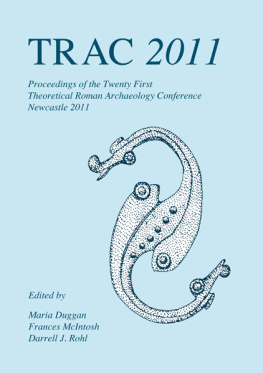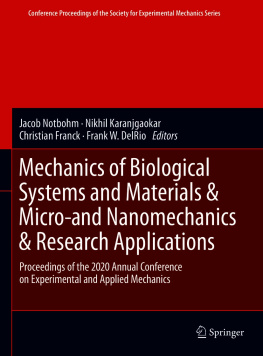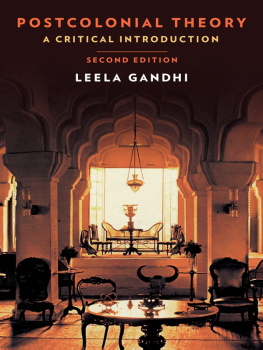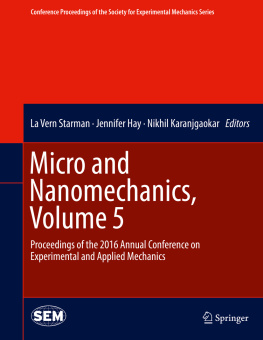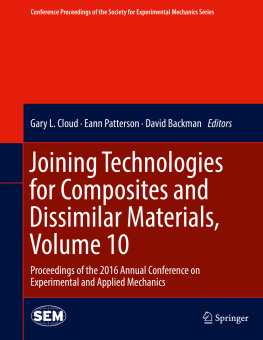Published by
Oxbow Books, Oxford, UK
TRAC and the individual authors, 2009
ISBN 978 1 84217 351 0
EPUB ISBN: 978 1 78297 325 6
PRC ISBN: 978 1 78297 326 3
A CIP record for this book is available from the British Library
This book is available direct from
Oxbow Books, Oxford, UK
(Phone: 01865-214249; Fax 1865-794449)
and
The David Brown Book Company
PO Box 511, Oakville, CT 06779, USA
(Phone: 860-945-9329; Fax 860-945-9468)
or from our website
www.oxbowbooks.com
Cover: Silenus, at the end of a handle of a 1st3rd century bronze jug, found at Herwen-Bijlandse Waard,
after Koster, A. 1997. The Bronze Vessels 2. Aquisitions 1954-1966 (including vessels of pewter and
iron). Descriptions of the Collections in the Provinciaal Museum G. M. Kam at Nijmegen 13. Nijmegen:
26. Drawing by R.P. Reijnen, by courtesy of Museum Het Valkhof, Nijmegen.
Printed in Great Britain by
Short Run Press, Exeter
Preface
The eighteenth annual Theoretical Roman Archaeology Conference was held at the Amsterdam Archaeological Centre in the University of Amsterdam, April 4-6 2008. It was the first ever TRAC to be organised outside of the United Kingdom. The decision to bring TRAC to the Continent, and The Netherlands in particular, was inspired by the increasing international character of TRAC. It was thought that a continental TRAC would attract an even more international audience and hereby further diversify the opinions offered and voices heard in Roman archaeology. As TRAC 2008 was attended by over 200 delegates from fifteen different countries, we feel it can be considered a success. In the course of two days, over sixty papers were read in eleven different sessions. Many of these papers were sent in for the proceedings. Out of these we, with the help of anonymous reviewers, selected fourteen papers that stood out in their contents and scope and fitted in the TRAC tradition of evidence-based theoretical studies.
A first group of papers deals with space, from how the Romans experienced space and tried to control it to how archaeologists can use spatial analysis. Hannah Friedman discusses how the concept of panoptic surveillance can be applied to the spatial organisation of forced labour in Faynan. Drawing on theoretical architecture, Cecilia Courbot-Dewerdt explores the way space was demarcated in Gaulish Iron Age enclosures and Gallo-Roman villae and what this can tell about the changing relationship between people and their surrounding countryside. The next two papers take us to the Urbs itself. David Newsome focuses on Lefebvres theories of urban centrality and the ways in which they might inform a rethinking of our own definition of centrality in the Roman city, while Simon Malmberg takes the reader on a walking-tour through Rome to demonstrate how one navigated an urban environment and how this influenced the perception and use of space. Tom Brindles paper closes off this section. In this paper he demonstrates the added value of the Portable Antiquities Scheme data for our knowledge on the density of settlement and continuity of habitation in Roman Britain.
The central theme of the second group of papers is food, both the production and the consumption of it. On the basis of Stable Isotope Analysis on excavated human bones Colleen Cummings challenges the commonly held opinion of a mainly vegetarian diet for most residents of Roman Britain. Ivo Vossen and Maaike Groot draw on archaeozoological and botanical data as well as on settlement density studies for their investigation of the Batavian rural economy and its relationship with the large body of soldiers stationed along the Dutch limes. Similarly concerned with the provisioning of Roman soldiers is Sue Stallibrass paper. Focusing on Hadrians Wall, where evidence for local stock breeding is lacking, she considers the well-documented post-Medieval droving system in northern Britain as a potential model for Roman methods of livestock production and supply.
A third section is formed by five papers on identity and the status of the individual within his or her social network. First, Laura Crowley uses the Roman tumuli in the civitas Tungrorum as a case study on identity formation in a post-conquest period, arguing that by erecting these tumuli the new local elites tried to create a sense of ancestry. Amy Richardson turns to issues of gender in Republican Samnium. Based on historical sources the Samnites are stereotyped in modern scholarship as rustic warriors, while Samnite women are altogether ignored. Using material culture, especially grave goods, she demonstrates the existence of a far more complex social structure. Likewise, Eef Stoffels uses material culture, in this case handmade pottery, to question our views on the identity and social networks of the inhabitants of Augustan legionary fortresses. On a more abstract level Robert Wanner explores the tension between the concepts of individuality and community within Roman archaeology and pleads for studying the individual within his or her social structure. Exactly this point is taken up by Miko Flohr, who uses the material remains of fullonicae for a case study on the social landscape of the workers in various cities in Roman Italy.
The volume closes with a paper by Martin Goldberg on the problematic concept of Romano-Celtic religion. As a possible solution he presents the notion of vernacular religion. Instead of beginning the analysis of religion and ritual in the Roman provinces from two opposing preconceived notions of Roman or native, or ethnic constructs of Roman culture and Celtic tradition, vernacular religion potentially shifts focus to the localised context of the material culture associated with ritualised practices.
The organisation of the 18th Theoretical Roman Archaeology Conference, and the publication of its proceedings, would not have been possible without the help and support of a large number of persons and institutions. For financial support we are very grateful to the University of Amsterdam, the VU University Amsterdam, the Radboud University Nijmegen, the Society for the Promotion of Roman Studies and Barbican Research Associates. Practical advice was given by present and former members of the TRAC Standing Committee, and numerous students assisted in the day-to-day practicalities during the conference. Trying to edit a reviewed volume of English papers with an editorial team entirely consisting of Dutch people, verges on hubris. Therefore many thanks go to James Bruhn, Ben Croxford, Carol van Driel-Murray, Andy Gardner, Helen Goodchild and Steve Willis for their help in the language-editing of the various contributions. A lot of work was done, and good advice given, by the anonymous reviewers. Yet the final selection of the papers to be published, and hence all responsibility for this decision, lies with the editorial team. Dieuwertje Smal was very kind to help with the setting of the papers. We are very grateful to Oxbow Books, for continuing its tradition to publish these proceedings Finally, we would like to thank the many people that visited Amsterdam, in particular those who spoke at TRAC 2008, and those who submitted their papers for publication in these conference proceedings.
The path that led to a TRAC in Amsterdam started in the winter term of 1999, when three out of the five organisers participated in a research seminar on Roman Britain at the University of Amsterdam, led by Carol van Driel-Murray, who had been involved in TRAC since its early years. She quite literally flooded us with TRAC proceedings as a source of inspiration for our seminar papers. Ignited by her enthusiasm, the entire seminar group then decided to attend the London TRAC of 2000. From that point onwards, this group became a regular attendant of TRAC and spread the news to friends at other universities and new students. The Dutch have become a constant factor at TRAC ever since. And again, when the idea arose to organise a continental TRAC it was Carol van Driel-Murray who stimulated us to have a go at it. Therefore we would like to dedicate this volume to her.



